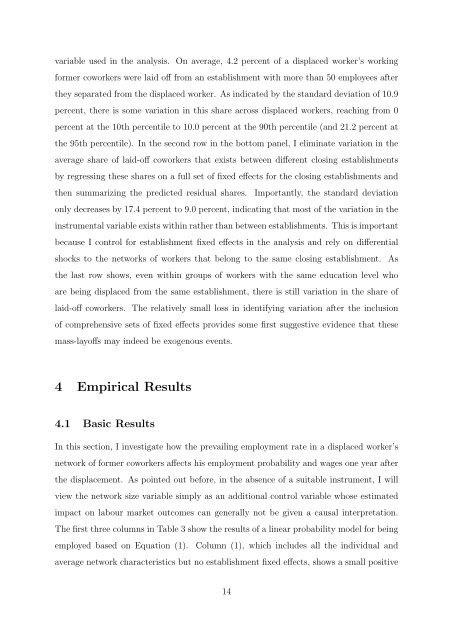paper - Universitat Pompeu Fabra
paper - Universitat Pompeu Fabra
paper - Universitat Pompeu Fabra
You also want an ePaper? Increase the reach of your titles
YUMPU automatically turns print PDFs into web optimized ePapers that Google loves.
variable used in the analysis. On average, 4.2 percent of a displaced worker’s working<br />
former coworkers were laid off from an establishment with more than 50 employees after<br />
they separated from the displaced worker. As indicated by the standard deviation of 10.9<br />
percent, there is some variation in this share across displaced workers, reaching from 0<br />
percent at the 10th percentile to 10.0 percent at the 90th percentile (and 21.2 percent at<br />
the 95th percentile). In the second row in the bottom panel, I eliminate variation in the<br />
average share of laid-off coworkers that exists between different closing establishments<br />
by regressing these shares on a full set of fixed effects for the closing establishments and<br />
then summarizing the predicted residual shares. Importantly, the standard deviation<br />
only decreases by 17.4 percent to 9.0 percent, indicating that most of the variation in the<br />
instrumental variable exists within rather than between establishments. This is important<br />
because I control for establishment fixed effects in the analysis and rely on differential<br />
shocks to the networks of workers that belong to the same closing establishment. As<br />
the last row shows, even within groups of workers with the same education level who<br />
are being displaced from the same establishment, there is still variation in the share of<br />
laid-off coworkers. The relatively small loss in identifying variation after the inclusion<br />
of comprehensive sets of fixed effects provides some first suggestive evidence that these<br />
mass-layoffs may indeed be exogenous events.<br />
4 Empirical Results<br />
4.1 Basic Results<br />
In this section, I investigate how the prevailing employment rate in a displaced worker’s<br />
network of former coworkers affects his employment probability and wages one year after<br />
the displacement. As pointed out before, in the absence of a suitable instrument, I will<br />
view the network size variable simply as an additional control variable whose estimated<br />
impact on labour market outcomes can generally not be given a causal interpretation.<br />
The first three columns in Table 3 show the results of a linear probability model for being<br />
employed based on Equation (1). Column (1), which includes all the individual and<br />
average network characteristics but no establishment fixed effects, shows a small positive<br />
14
















